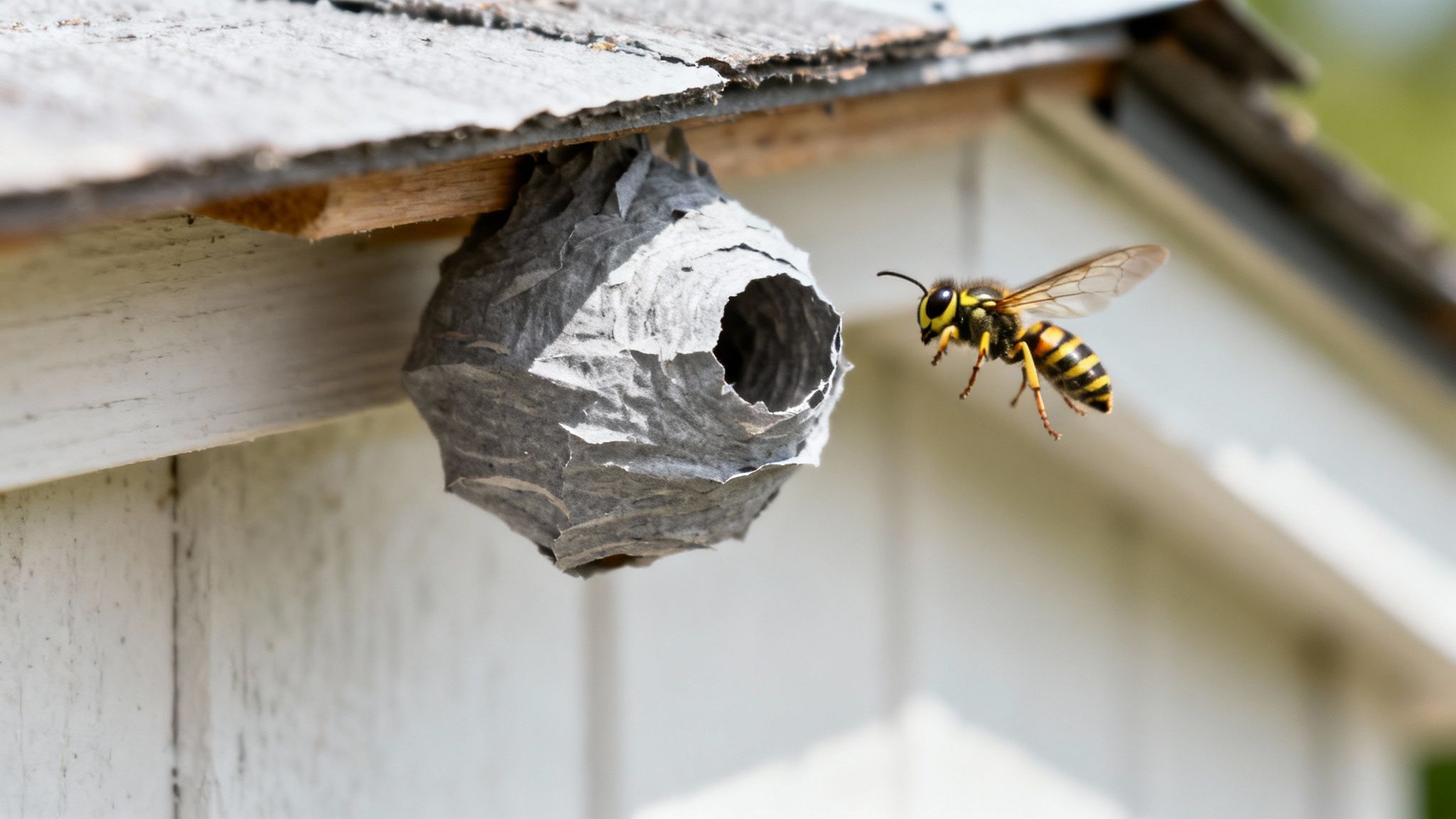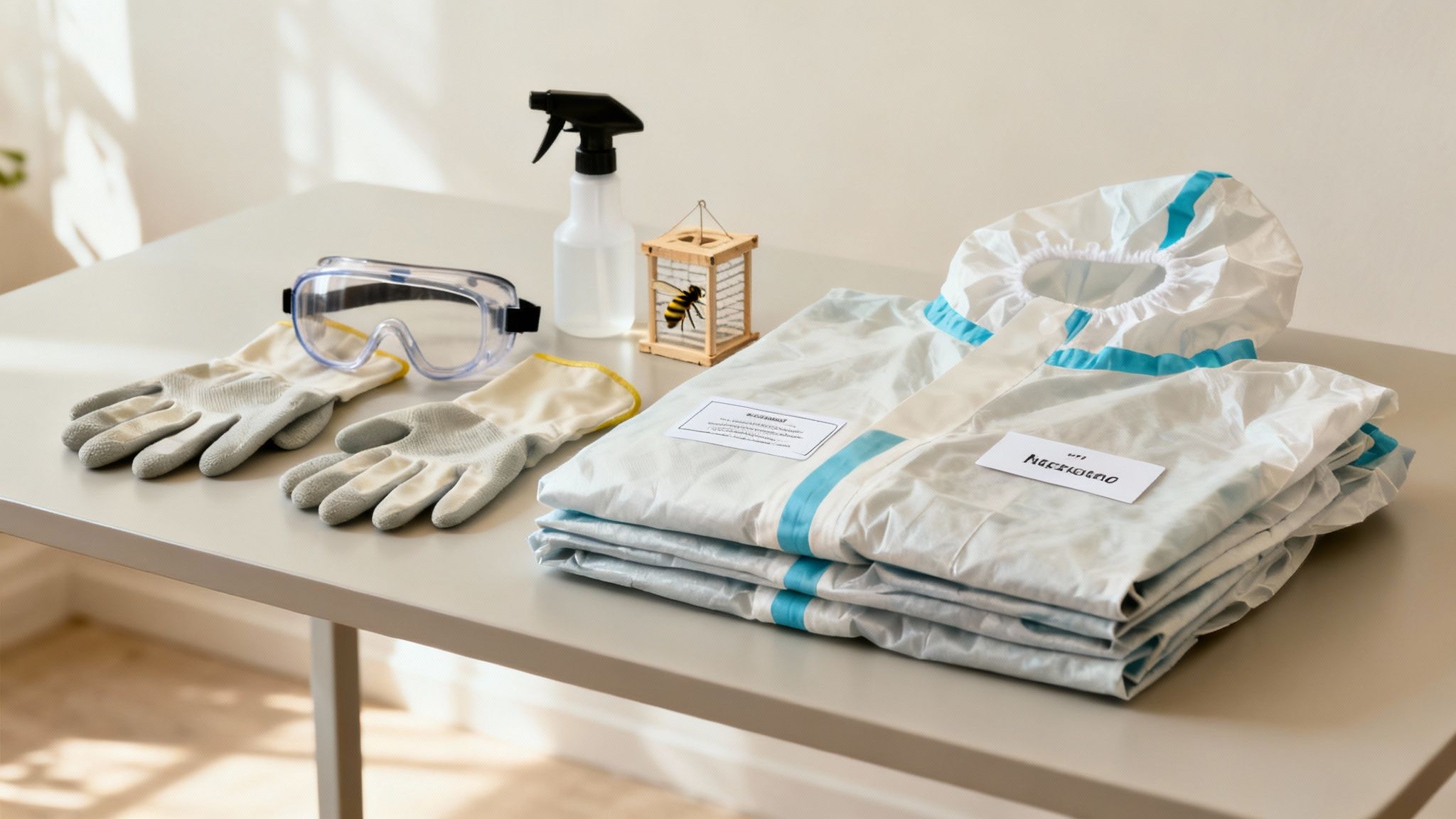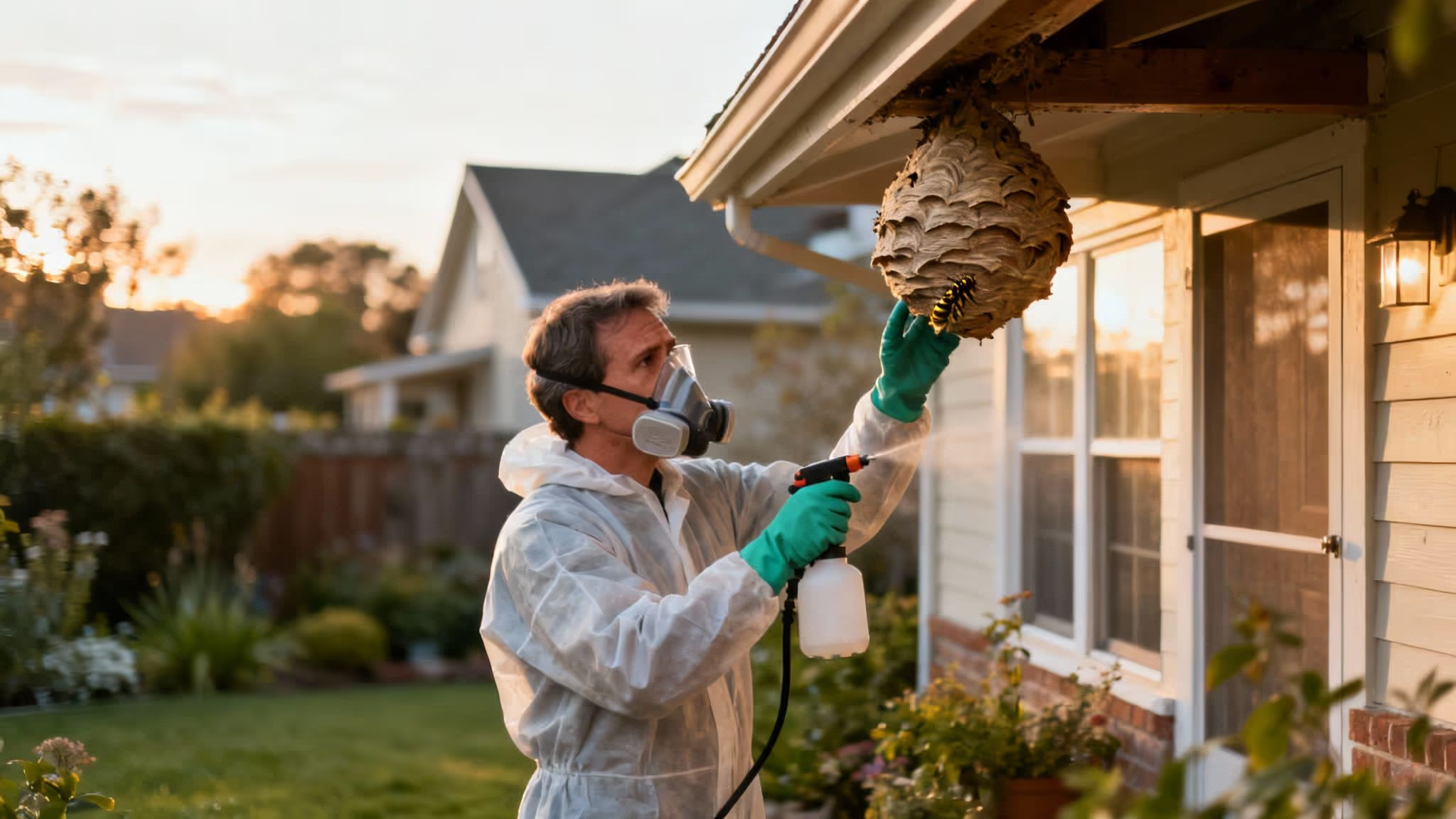Finding a wasp nest near your home is always a bit unnerving. The first thing to do is take a breath and figure out what you're dealing with. Knowing how to get rid of wasps safely begins with a calm assessment from a good distance—this will tell you whether it's a job you can tackle yourself or if you need to bring in a professional pest controller.
Your First Steps for Dealing with Wasps

Discovering a busy wasp nest can really throw a spanner in the works, especially if it’s near your patio, front door, or anywhere your family spends time. That constant buzzing is enough to put anyone on edge. But before you reach for the nearest can of bug spray, it's vital to properly understand the situation.
The first step is always observation. Your goal is to gather as much information as you can without getting too close. Stay at least 5 to 7 metres away to avoid disturbing them. An agitated colony is the last thing you want; they can become aggressive in an instant, and unlike bees, a single wasp can sting you repeatedly.
Assess the Situation Safely
From your safe spot, watch where the wasps are flying in and out. This will pinpoint the exact location of the nest. It could be obvious, like under the eaves, but it might also be tucked away in a loft, inside a garden shed, or even hidden in a hole in the ground. Where the nest is and how big it is are the two most important factors in deciding what to do next.
Here’s what you should be looking for:
- Is the nest easy to get to? A small nest hanging from a low tree branch is a world away from one hidden deep inside a wall cavity or perched high up on a roofline.
- How big is the colony? Watch the traffic. Just a few wasps buzzing about might mean it's a new, small nest. But if you see a constant, heavy stream of them, you're likely looking at a large, well-established colony that's far more dangerous.
- What time of year is it? Nests are at their smallest in early spring when the queen is just starting to build. By late summer, that same nest could be home to thousands of wasps, making it a much bigger problem.
Taking the time to observe these things will help you make a smart, informed decision. Getting it wrong could provoke a swarm, and that’s a genuinely dangerous situation.
I’ve seen it before—homeowners often underestimate just how fiercely a wasp colony will defend its home. Even a nest that looks small on the outside can be teeming with hundreds of territorial wasps ready to attack. Your safety has to be the top priority.
Once you have a clear picture, you can decide on the best course of action. If you’re planning any garden parties, dealing with the nest quickly and safely is a must. After it's gone, you can get back to planning that perfect outdoor barbecue area.
DIY vs Professional Wasp Removal: A Quick Comparison
Not sure which path to take? This table quickly breaks down the pros and cons of tackling a wasp nest yourself versus calling in a certified pest controller.
Ultimately, while a DIY approach can save you a bit of money on a very small, manageable nest, the safety and guaranteed results of a professional service are often well worth the cost for anything larger or harder to reach.
How to Identify Nests and Assess the Threat

Before you even think about getting rid of wasps, you need to play detective. Honestly, understanding what you're up against is the most critical part of the whole process. It dictates your next move and, more importantly, keeps you safe. Rushing in without a proper assessment is a recipe for a very painful afternoon.
First things first: are you sure they're wasps? In the UK, the usual suspects ruining your barbecue are the Common Wasp (Vespula vulgaris) and the German Wasp (Vespula germanica). They both have that classic bright yellow-and-black striped body, a very distinct narrow "waist," and look smooth rather than fuzzy.
This is a crucial distinction because they’re often mistaken for bees. Bees are our friends—they're essential pollinators! You'll notice bees, like bumblebees or honeybees, are generally rounder, hairier, and their colours are less aggressive. Taking a moment to observe from a safe distance can prevent you from harming beneficial insects by mistake.
Locating the Source of the Problem
Once you've confirmed it's wasps, the real hunt begins: finding their home. Wasps are surprisingly opportunistic builders and can set up shop in all sorts of places. Knowing where they like to nest will give you a head start.
Here are the most common hideouts I've seen over the years:
- Inside Buildings: Lofts, sheds, garages, and wall cavities are perfect, sheltered spots. Keep an eye out for a steady stream of wasps flying in and out of a small hole or gap.
- Up High: Eaves, roof spaces, and even those dense climbing plants on the side of your house are prime real estate for them. These nests can be particularly tricky to reach.
- Underground: Some species, especially German Wasps, love nesting underground. Check old rodent burrows, compost heaps, or look for activity around loose paving slabs. These nests are often invisible until you’re practically on top of them.
The nest's location has a massive impact on the risk level. A nest tucked away in a garden shed you rarely use is far less of an immediate threat than one buzzing right above your back door. Likewise, a nest near delicate potted plants requires a more careful approach. If that's your situation, it's worth getting some tips on how to garden with potted plants to avoid disturbing the nest while you figure out a plan.
Judging the Size and Activity of the Nest
To find the nest, don't just wander about. Find a safe observation point—at least 5-7 metres away—and just watch. Wasps are creatures of habit and fly in a direct line back to their nest. By tracking their flight path, you can pinpoint the entrance.
The amount of "traffic" is your best indicator of the colony's size. A wasp flying in or out every few seconds points to a large, established colony, which could easily house thousands of wasps. On the other hand, seeing only one or two every minute might mean it's a new nest, maybe only the size of a golf ball.
A common mistake is judging a nest’s size just by what you can see. That small entrance hole in your wall might look harmless, but the nest inside could be enormous, filling a huge part of the cavity. The level of activity is a far more reliable guide to the real threat.
Getting a realistic grasp of the danger is non-negotiable. If you disturb a large, active colony, you could trigger a defensive swarm where hundreds of wasps attack at once. This is incredibly dangerous, especially for anyone with an allergy.
Nests in awkward spots, like high up on a roofline or deep inside a wall, also multiply the risk. Trying to access them without the right equipment is hazardous, and a failed attempt will only make the wasps angrier and more aggressive. This is the moment you have to be honest with yourself and decide if it's a job you can handle alone.
Effective DIY Methods for Small Wasp Nests

If you’ve spotted a small, accessible nest early in the season, you might be tempted to tackle it yourself. And in some cases, you absolutely can. But let's be clear: taking on a wasp nest, no matter the size, isn't a casual garden chore. It demands respect and proper preparation. One wrong move can turn a small nuisance into a very angry, very dangerous swarm.
The single most important factor for a safe DIY job is timing. Wasps are far less active and aggressive when it’s cool, making dusk and dawn the ideal times to act. At these times, the whole colony is back home in the nest, meaning you can treat them all in one go. Trying to do this in the middle of a hot afternoon when they're buzzing about is simply asking for a world of pain.
Getting Kitted Out for Safety
Before you even think about approaching that nest, you need to get your protective gear sorted. This part is completely non-negotiable. A few stings are bad enough, but for some people, they can be life-threatening.
Here's what your safety checklist should look like:
- Head-to-toe coverage: Think thick, long-sleeved clothing, trousers, proper gloves, a hat, and fully enclosed shoes. I always recommend tucking your trousers into your socks and your sleeves into your gloves – leave absolutely no skin exposed.
- Face and neck protection: A beekeeper's veil is the gold standard here. Your face is incredibly vulnerable, and a proper veil is the only way to reliably protect it.
- A clear escape route: This sounds obvious, but it’s amazing how often it’s overlooked. Before you start, plan your retreat. Clear away any trip hazards like garden hoses, kids' toys, or stray tools. You need to be able to back away quickly and without incident.
Once you’re kitted out and know your escape path, you can decide on your weapon of choice.
Using Specialist Sprays and Dusts
The most reliable DIY tools are the insecticidal sprays and dusts made specifically for wasps. You can find these at most garden centres and hardware shops. Make sure you buy a product designed for wasps or hornets; a standard fly spray just won't cut it.
If you're using an aerosol spray, look for one that shoots a long-range jet. This lets you keep a safe distance of 4-5 metres from the nest while you're applying it. Give the nest entrance a good, thorough dousing for about 10-15 seconds. You want to make sure the spray gets deep inside.
Insecticidal dust is another great option, especially for nests tucked away in awkward spots like wall cavities or underground burrows. A powder duster allows you to puff a good amount of the product directly into the nest entrance. The returning wasps will carry the dust further into the nest on their bodies, helping to spread it through the colony.
Crucial Tip: As soon as you've finished applying the treatment, get out of there. Don't hang around to watch. The wasps will become extremely agitated, and you need to be well clear before that happens.
It can take 24-48 hours for the entire colony to be eliminated. Keep an eye on the nest from a distance, and if you still see activity after a couple of days, you might need to apply a second treatment.
Natural and Alternative Methods
For those who’d rather avoid chemicals, there are a few natural methods, but it's important to understand their limitations. Their effectiveness is a world away from a dedicated insecticide.
Homemade wasp traps, often made from a plastic bottle with a sugary bait like pop or fruit juice, are brilliant for catching the odd foraging worker wasp around your patio. But they will not get rid of a nest. The queen can lay hundreds of eggs a day, so trapping a handful of workers won't make the slightest difference to the colony's numbers.
Likewise, peppermint oil sprays can be a decent deterrent. A mixture of peppermint oil, water, and a little dish soap sprayed on eaves or window frames might discourage a new queen from building there. It is not, however, a weapon for destroying an established nest.
These natural approaches are best used for prevention or managing low numbers of stray wasps. When you're dealing with an active, established colony, safety and effectiveness have to be your top priorities. Some gardeners swear by diatomaceous earth, but for it to work, you need direct contact with the insects, which is risky. For other non-toxic garden tips, you can find inspiration for making homemade plant food that will help your plants thrive.
Keeping Wasps From Coming Back

Getting rid of a wasp nest is a huge relief, but the job isn't quite done. Winning that battle is one thing, but the real victory is making sure a new colony doesn’t set up shop in the same spot next year. This means shifting your mindset from reactive removal to proactive prevention, making your property a much less appealing option for a queen wasp looking for a new home.
When a queen emerges from hibernation in the spring, she’s on a mission to find one thing: a safe, sheltered spot to build her colony. By making your home and garden less inviting, you can convince her to move on. These long-term strategies are quite straightforward, mostly involving a bit of seasonal maintenance and some simple habit changes that can make all the difference.
Fortifying Your Home's Defences
Think of your home's exterior as its first line of defence. Every small gap, crack, or unsealed opening is a potential VIP entrance for a determined queen wasp. Giving your property a thorough once-over a couple of times a year helps you spot and seal these vulnerabilities before they become a real headache.
Pay close attention to these common weak points:
- Seal Up Cracks and Gaps: Look over your brickwork, siding, and foundation for any cracks. A tiny opening is all a queen needs to slip inside and start a nest within your wall cavities. A simple tube of exterior caulk or sealant is your best friend here.
- Check Eaves and Soffits: The area where your roof meets the walls is prime real estate for wasps. Keep an eye out for damaged soffits, loose fascia boards, or gaps under the eaves. These sheltered spots are absolute magnets for nests, so keeping them in good repair is vital.
- Install Insect Mesh: Air bricks and ventilation grilles are essential for airflow, but they’re also open doors for wasps. You can easily fit a fine-gauge insect mesh over them to block access without restricting ventilation.
These small maintenance jobs don’t just stop wasps; they also contribute to the overall health of your home, protecting it from moisture and other pests too.
Making Your Garden Less Attractive
Your garden can either be an all-you-can-eat buffet for wasps or a place they'd rather avoid. A few smart garden management habits can tip the scales in your favour, getting rid of the very things that attract them in the first place. Wasps are drawn to sweet, sugary foods and protein, especially in late summer as their natural food sources start to run out.
By getting a handle on these attractants, you can dramatically cut down on the number of wasps buzzing around. It also means fewer scouts will be reporting back to a queen that your garden is the perfect spot for a new nest.
The goal isn't to get rid of every single wasp—they do a great job of controlling garden pests, after all. The aim is to create an environment where they don't feel the need to build a nest right by your back door.
Here are a few practical habits to get into:
- Manage Your Bins: Always keep the lids on your outdoor rubbish and compost bins sealed tightly. A single overflowing bin can be an open invitation to wasps from all over the neighbourhood.
- Clear Up Fallen Fruit: If you have fruit trees, make a point of clearing up any windfalls. Rotting apples, plums, and pears are a massive draw for sugar-hungry wasps.
- Plant Wasp-Repellent Plants: Some plants have strong scents that wasps can't stand. Try planting species like mint, thyme, eucalyptus, or lavender around your patio and doorways. For tips on getting them to thrive, check out this guide on growing lavender indoors.
Changing weather patterns are also having an impact. Wasp season in the UK usually kicks off in April, peaking around August and September. However, warmer recent years have caused these timelines to shift. Pest controllers have reported huge increases in call-outs, with one particularly warm summer seeing wasp populations peak two months early. Nests were reaching their maximum size by June, making these preventative measures more crucial than ever. You can read more about how weather affects wasp populations in the UK here.
When to Call in the Professionals
While tackling a tiny, brand-new nest yourself can feel satisfying, there are plenty of situations where it’s not just a bad idea—it’s downright dangerous. Knowing when to step back and pick up the phone is the most important part of staying safe.
Calling a professional pest controller isn’t admitting defeat; it’s making a smart, sensible decision. They have the right gear, the proper training, and the experience to handle jobs that would be incredibly risky for the average homeowner.
High-Risk Nest Locations
The location of a wasp nest is often the biggest red flag. If you see a nest in any of these spots, it’s time to call for backup. It’s not about convenience, it’s about your safety.
Some of the trickiest locations include:
- Nests Up High: A nest tucked under the eaves, high on a roofline, or way up in a tree is a job for a pro. Trying to deal with it while wobbling on a ladder is asking for trouble. A fall is bad enough, but add a swarm of angry wasps into the mix and you’ve got a recipe for a trip to the hospital.
- Hidden Nests: Sometimes the worst nests are the ones you can’t even see. Wasps love to build inside wall cavities, lofts, or even underground. A standard aerosol spray from the shop just won’t cut it; it won’t penetrate deep enough to get to the queen. Professionals use specialised equipment, like long-reach lances and insecticidal dust applicators, to get the treatment right to the heart of the colony.
- Public or High-Traffic Areas: If the nest is near a public footpath, a neighbour’s garden, or a kids' play area, the risk is just too great. Leave it to a professional who can manage the situation with public safety as the number one priority.
When the Nest Is Just Too Big
Size really does matter with wasp nests. A small, golf-ball-sized nest you spot in spring might only have the queen and her first few workers. Fast forward to late summer, and that same nest can swell to the size of a beach ball, humming with 5,000 wasps or more.
An established colony this large is a force to be reckoned with. They are highly protective of their home, and disturbing them will trigger a massive, coordinated attack. If you see a constant stream of wasps flying in and out of a single point, you're looking at a mature nest. Don't even think about tackling it yourself.
I've seen some surprisingly huge nests over the years. With our changing weather patterns, colonies are growing much faster than people expect, turning a small problem into a serious hazard in just a matter of weeks.
The Allergy Factor
This is non-negotiable. If anyone in your house—or even a close neighbour—has a known allergy to wasp stings, do not attempt a DIY removal. It’s as simple as that.
For someone with a severe allergy, a single sting can cause anaphylaxis, a life-threatening reaction that needs urgent medical help. The risk is immense and absolutely not worth taking. Professional pest controllers are trained to handle the removal in a way that minimises the chance of stray wasps harming anyone nearby.
The demand for professional help is on the rise as more people realise the risks. For example, Highland Pest Control reported a huge jump in call-outs, with one team treating 317 nests in a single season, way up from their usual 40-60. This was linked to warmer weather making nests grow faster, with some homes having five or more nests in one roof alone. You can read more about this recent wasp season activity on their site.
The Professional Advantage
So, what do you get when you hire a pro? For starters, they have access to commercial-grade insecticides that are far more powerful than anything you can buy over the counter. These products are designed to wipe out the entire colony quickly and effectively.
They also turn up in full protective gear, allowing them to work safely even when faced with a furious swarm. They understand wasp behaviour inside and out, which means they can get the job done right while keeping you and your family safe. For a pretty reasonable fee, you get a guaranteed solution and, most importantly, peace of mind.
Common Questions About Wasp Removal
Even with a solid plan, it’s completely normal to have a few lingering questions when you’re dealing with a wasp problem. Getting some clear answers can help you feel much more confident about tackling the issue safely. Let's run through some of the most frequent queries we get.
A bit of extra knowledge, from spotting an active nest to knowing what to budget for, makes the whole situation far less daunting.
How Can I Tell If a Wasp Nest Is Active?
The most obvious giveaway of an active nest is a constant stream of wasps flying to and from a single spot. During the day, you'll see a very clear, busy flight path as they head out to forage and return home.
To check without getting too close, stand back at least 5 to 7 metres and just watch for a few minutes. If you see that consistent, two-way traffic, you've got a live colony on your hands.
An old, inactive nest is a different story. It will look grey and papery, often appearing brittle or damaged from winter weather. The most important clue? No wasps. Wasps never reuse an old nest, so if you find one from a previous year, you can safely knock it down and dispose of it without any worry.
What Does Professional Wasp Nest Removal Cost in the UK?
Getting the professionals in is often the smartest move, but what’s it going to cost? In the UK, you can typically expect to pay between £60 and £100 for a straightforward wasp nest removal.
Of course, that price can shift depending on a few things:
- Accessibility: A nest tucked away in your garden shed is usually on the cheaper end of the scale.
- Location Complexity: If the nest is high up under the eaves, deep inside a wall cavity, or in a tricky loft space, it'll cost more. This is because the technician will need specialist equipment and more time to do the job safely.
- Urgency: Need it gone today? Some pest controllers offer a same-day or emergency call-out service, which usually comes at a premium.
I always recommend getting a couple of quotes from reputable, certified pest control services in your area. It lets you compare not just the price but the service they're offering.
Remember, you're not just paying for someone to get rid of a nest. You're investing in their expertise, professional-grade equipment, and the guarantee that the problem will be solved correctly and safely. That peace of mind is worth a lot.
Will Wasps Go Away on Their Own?
Technically, yes, the colony will eventually die off naturally. But you'll be waiting until the first hard frosts of late autumn or early winter. This is when the entire colony—worker wasps, drones, and the original queen—perishes.
Only the new, young queens that have recently mated will survive. They fly off to find a sheltered spot to hibernate, like deep in a woodpile or a crack in a wall, ready to emerge the following spring and start the cycle all over again.
So, while waiting it out might work for a nest that's at the far end of the garden and not bothering anyone, it’s not a realistic or safe plan if the nest is anywhere near your home or high-traffic areas. The colony will only get bigger and more aggressive as the summer progresses, increasing the risk of stings. If you're looking forward to enjoying your garden, it's best to deal with them sooner rather than later. Once they're gone, you'll find plenty of great garden entertaining ideas to make the most of your wasp-free space.




